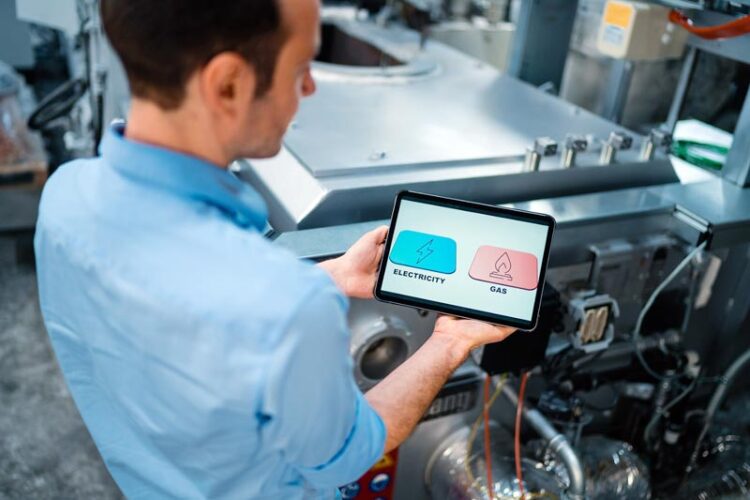Compensating for grid fluctuations with bivalent furnaces

Bivalent crucible furnaces can switch dynamically between electricity and gas during operation.
© Fraunhofer IPA/Ludmilla Parsyak
Energy-flexible operation of pressure die-casting systems.
Due to the high energy consumption of melting and holding furnaces, the price of the energy source represents a significant cost factor in the production of castings. The price of electricity fluctuates over the course of the day. As a result, companies should design their energy consumption flexibly. Together with its partners, the Fraunhofer Institute for Manufacturing Engineering and Automation IPA is developing a bivalent furnace that enables dynamic switching between gas and electricity. This will ensure that operation is flexible in terms of the type of energy deployed, allowing energy to be used when it is most cost-efficient.
Pressure die-casting is one of the most efficient molding processes — a single mold can be used to produce hundreds of thousands of castings. But like so many industrial processes, this production method is extremely energy-intensive, with crucible furnaces leading the charge in terms of considerable energy consumption. Such furnaces are used to melt metal ingots which are then pressed into a metallic mold at high pressure and speed. The total energy consumption of German light-metal foundries is accordingly high; it was recorded at 4.4 TWh by the German Federal Statistical Office in 2019. By designing a solution which renders production processes more flexible in terms of the energy used, Fraunhofer is helping companies to compensate for fluctuations in the power grid and reduce their production costs.
Bivalent furnace technology is the key to energy-flexible operation. “Furnaces are typically operated using only one energy source — either fuels such as gas and oil or alternatively electricity. Bivalent crucible furnaces, however, can switch dynamically between electricity and gas during operation. This technology has not been available until now,” explains Alexander Mages, a researcher at Fraunhofer IPA in Stuttgart. “It means that we can use different energy sources to cover the energy requirements of crucible furnaces in any operating state.”
Working with partners Hindenlang GmbH, Bark Magnesium GmbH and the Institute for Energy Efficiency in Production (EEP) at the University of Stuttgart, the research team has modeled various heating concepts, optimized plant designs through thermal simulations and implemented the bivalent design into a crucible furnace. The crucible furnace forms part of a plant center including punches, presses and CNC machines at Bark Magnesium GmbH’s die-casting foundry. Tested successfully in April 2023, it was commissioned in May to melt magnesium ingots.
Uninterrupted production processes
Given that the melt has to be kept at a constant operating temperature, the researchers’ aim was to use energy flexibly, at ideal electricity prices, without having to interrupt the production process due to a changeover. This means that the bivalent furnace can be switched to gas operation when the electricity price is particularly high — for example, due to the regular increase of electricity consumption in the mornings or evenings. When prices are low, on the other hand, the system switches to electricity operation. “An energy-flexible demand for electricity can contribute significantly to reorienting our electricity system toward renewable energy generation. Industrial companies account for 44 percent of our total electricity consumption,” says Mages.
Operators can switch manually between electricity and gas using the furnace control system or the furnace switches automatically via a signal issued by the hall network. Likewise, the hall network connection provides the option of switching after receiving a signal from the electricity supplier. “By switching the energy source, the process start time does not have to be postponed to when electricity prices are low, nor do shifts have to be adapted to accommodate break times. These are common measures to achieve flexibility in terms of energy,” the researcher points out, explaining another advantage of the bivalent furnace.
The furnace was developed as part of the Kopernicus project SynErgie II, funded by the German Federal Ministry of Education and Research (BMBF). An application has already been submitted for the follow-up project, SynErgie III, which aims to optimize the furnace, including its heating and network design. Using thermal measuring elements, the project partners are determining parameters such as temperature distribution in the furnace to draw conclusions about energy efficiency. They are also testing whether the furnace can be operated with hydrogen. “It’s almost as if we are conducting research on a live object,” describes Mages.
Weitere Informationen:
https://www.fraunhofer.de/en/press/research-news/2023/june-2023/compensating-for…
Media Contact
All latest news from the category: Power and Electrical Engineering
This topic covers issues related to energy generation, conversion, transportation and consumption and how the industry is addressing the challenge of energy efficiency in general.
innovations-report provides in-depth and informative reports and articles on subjects ranging from wind energy, fuel cell technology, solar energy, geothermal energy, petroleum, gas, nuclear engineering, alternative energy and energy efficiency to fusion, hydrogen and superconductor technologies.
Newest articles

Innovative 3D printed scaffolds offer new hope for bone healing
Researchers at the Institute for Bioengineering of Catalonia have developed novel 3D printed PLA-CaP scaffolds that promote blood vessel formation, ensuring better healing and regeneration of bone tissue. Bone is…

The surprising role of gut infection in Alzheimer’s disease
ASU- and Banner Alzheimer’s Institute-led study implicates link between a common virus and the disease, which travels from the gut to the brain and may be a target for antiviral…

Molecular gardening: New enzymes discovered for protein modification pruning
How deubiquitinases USP53 and USP54 cleave long polyubiquitin chains and how the former is linked to liver disease in children. Deubiquitinases (DUBs) are enzymes used by cells to trim protein…



